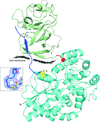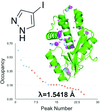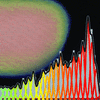issue contents
January 2016 issue

editorial
CHEMISTRY | CRYSTENG
Crystal engineering is discussed, along with its three key concepts: crystal packing; the design of solids; and physical and chemical properties.
feature articles
CRYO | EM
In this overview, we briefly outline recent advances in electron cryomicroscopy (cryoEM) and explain why the journal IUCrJ can provide a natural home for publications covering many present and future developments in the cryoEM field.
scientific commentaries
MATERIALS | COMPUTATION
Materials with the much-loved perovskite structure are being used to develop and test new methods for interpreting local structural arrangements in crystals, and these methods are in turn uncovering unexpected new structural insight.
research papers
BIOLOGY | MEDICINE
Utilizing a peptide-anchoring strategy, transient signal-peptide complexes of a Gram-positive bacterial signal peptidase were trapped, revealing the atomic details of their interaction.
MATERIALS | COMPUTATION
The ability of the pair distribution function analysis of total scattering from a powder to determine the local ordering in ferroelectric PZN (PbZn1/3Nb2/3O3) is explored by comparing it with a model established using single-crystal diffuse scattering.
NEUTRON | SYNCHROTRON
The grain structure of a slightly deformed Al–0.3 wt%Mn alloy was reconstructed using diffraction contrast tomography (DCT) and high-energy diffraction microscopy (HEDM). The direct comparison shows that DCT can detect subgrain boundaries with disorientations as low as 1° and that HEDM and DCT grain boundaries are on average 4 µm apart from each other.
NEUTRON | SYNCHROTRON
Using the EMC algorithm, the three-dimensional intensity was successfully reconstructed from millions of non-oriented, sparse data frames collected from a hen egg-white lysozyme crystal rotating about a single axis. The protein structure was solved from the reconstructed intensity. This result is encouraging for the development of synchrotron-based serial microcrystallography.
BIOLOGY | MEDICINE
4-Bromopyrazole and 4-iodopyrazole bind to many small molecule binding hot spots in target proteins. This promiscuous binding enables the use of these compounds for experimental phase determination by single-wavelength anomalous dispersion (SAD). The low cost and safety of the compounds make them excellent choices for addition to the protein crystallographer's toolkit.
PDB references: proteinase K, 5cw1; influenza endonuclease, 5cxr; HIV-1 reverse transcriptase, 5cym; 5cyq
MATERIALS | COMPUTATION
Download citation


Download citation


Single-crystal X-ray diffraction data should be collected to the highest resolution as this allows for refinement of more reliable structural, thermal and dependent parameters. The results of refinements using a Transferable Aspherical Atomic Model of electron density (TAAM) appear to be in far better agreement with neutron results than the corresponding Independent Atom Model (IAM) results for all parameters, all resolutions and all compounds, and we advocate the use of this approach instead of IAM.
feature articles
MATERIALS | COMPUTATION
An overview of statistical parameter estimation methods is presented and applied to analyse transmission electron microscopy images in a quantitative manner.



 journal menu
journal menu




 access
access




















